The Bioremediation of Nutrients and Heavy Metals in Watersheds: The Role of Floating Treatment Wetlands
Abstract
1. Introduction
1.1. Background and Rationale for FTWs
Impacts of Polluted Water and Need for Nature-Based Solutions
1.2. Constructed Wetland (CW) Treatment
2. About Floating Treatment Wetlands (FTWs)
2.1. Free-Floating Macrophyte Wetlands
2.2. Floating Emergent Macrophyte Wetlands
2.3. Submerged Macrophyte Wetlands
2.4. Comparative Analysis: FTWs vs. Other Nature-Based Solutions (NBSs)
2.5. Advantages and Limitations of FTW Systems
2.6. Climatic Adaptability and Resilience of FTWs
2.7. FTW Treatment on Different Sources of Wastewater
2.7.1. Stormwater Runoff
2.7.2. Industrial Runoff
2.7.3. Greywater
3. Experimental Workflow and Design of FTWs
3.1. Indoor and Outdoor Experiments
- 1.
- Vegetation Presence: This included floating vegetation (FV) vs. without floating vegetation (NFV) (n = 3 each).
- 2.
- Gas and Light Control: This included FV microcosms with inhibited gas exchange, foil covers (light reduction), and plastic traps (gas restriction).
- 3.
- Nitrogen Loading: This included TDN increased from 1.4 to 4.1 mg N L−1 in FV + N and NFV + N (n = 3 each), with control groups included.
- 4.
- Temperature Elevation: This included FV and NFV with/without a 5 °C increase (n = 3 each).
3.2. Floating Mat Types
3.3. Mat Thickness
3.4. Soil vs. Without Soil
3.5. Optimal Harvest Time and HRT
3.6. Metrics for Assessing Plant Growth
3.7. Impact of Different Mesocosm Designs
3.7.1. Buoyancy
3.7.2. Durability
3.7.3. Stability
3.7.4. Structural Integrity
3.7.5. Design Geometry and Hydraulic Configurations
3.7.6. Scalability and Modularity
3.8. Plant Selection Criteria for FTWs
3.9. Microbial Interactions in FTWs
4. Water Quality Indicators in Evaluating FTWs’ Performance
4.1. Basic Measurement
4.1.1. DO, BOD, COD, and ORP
4.1.2. pH, Temperature, and Turbidity
4.1.3. Nutrient Analysis (TN and TP)
4.2. Biological Parameters
Microbial Analysis (CFUs and MGA)
4.3. Heavy Metal Analysis
4.4. Plant Tissue Analysis
4.5. Performance Metrics and Statistical Analysis
5. Conclusions
Author Contributions
Funding
Data Availability Statement
Conflicts of Interest
Abbreviations
| ACD | Activated Carbon Adsorption |
| AWPs | Above-water parts of plants |
| BWPs | Below-water parts of plants |
| BG | Bio-Granulation |
| BOD | Biological oxygen demand |
| BCF | Bioconcentration factor |
| CWs | Constructed wetlands |
| COD | Chemical oxygen demand |
| CFUs | Colony-forming units |
| DBTI | Dry biomass tolerance index |
| DO | Dissolved oxygen |
| FV | Floating vegetation |
| FTWs | Floating treatment wetlands |
| GHG | Greenhouse gas |
| HABs | Harmful algae blooms |
| HRT | Hydraulic retention time |
| HRL | Hydraulic loading rate |
| IC | Ion chromatography |
| ICP-MS | Inductively Coupled Plasma Mass Spectrometry |
| ICP-OES | Inductively Coupled Plasma Optical Emission Spectrometry |
| MAF | Micro-Air Flotation |
| DWB | Dry weight basis |
| NFV | Without floating vegetation |
| ORP | Oxidation–reduction potential |
| RLTI | Root length tolerance index |
| SLTI | Shoot length tolerance index |
| TKN | Total Kjeldahl Nitrogen |
| TN | Total nitrogen |
| TP | Total phosphorus |
| TSSs | Total Suspended Solids |
| TDN | Total dissolved nitrogen |
| TF | Translocation factor |
Appendix A
Appendix A.1. Available Water Treatment Strategies for Water Quality
Appendix A.1.1. MAF Treatment
Appendix A.1.2. ACD Treatment
Appendix A.1.3. BGCP Treatment
Appendix A.2. Plant Performance Metrics and Statistics Analysis in the FTW System
Appendix A.2.1. Pollutant Removal Efficiency and Removal Rate
Appendix A.2.2. Plant Growth Rate
Appendix A.2.3. Plant Tolerance Index
Appendix A.2.4. Heavy Metal Uptake
Appendix A.2.5. Data Processing and Statistical Analysis
References
- Gurau, S.; Imran, M.; Ray, R.L. Algae: A Cutting-Edge Solution for Enhancing Soil Health and Accelerating Carbon Sequestration—A Review. Environ. Technol. Innov. 2025, 37, 103980. [Google Scholar] [CrossRef]
- Colares, G.S.; Dell’Osbel, N.; Wiesel, P.G.; Oliveira, G.A.; Lemos, P.H.Z.; Da Silva, F.P.; Lutterbeck, C.A.; Kist, L.T.; Machado, Ê.L. Floating Treatment Wetlands: A Review and Bibliometric Analysis. Sci. Total Environ. 2020, 714, 136776. [Google Scholar] [CrossRef]
- Mfarrej, M.F.B.; Wang, X.; Fahid, M.; Saleem, M.H.; Alatawi, A.; Ali, S.; Shabir, G.; Zafar, R.; Afzal, M.; Fahad, S. Floating Treatment Wetlands (FTWs) Is an Innovative Approach for the Remediation of Petroleum Hydrocarbons-Contaminated Water. J. Plant Growth Regul. 2023, 42, 1402–1420. [Google Scholar] [CrossRef]
- Ijaz, A.; Shabir, G.; Khan, Q.M.; Afzal, M. Enhanced Remediation of Sewage Effluent by Endo-phyte-Assisted Floating Treatment Wetlands. Ecol. Eng. 2015, 84, 58–66. [Google Scholar] [CrossRef]
- Borne, K.E.; Fassman-Beck, E.A.; Winston, R.J.; Hunt, W.F.; Tanner, C.C. Implementation and Maintenance of Floating Treatment Wetlands for Urban Stormwater Management. J. Environ. Eng. 2015, 141, 04015030. [Google Scholar] [CrossRef]
- Sharma, R.; Vymazal, J.; Malaviya, P. Application of Floating Treatment Wetlands for Stormwater Runoff: A Critical Review of the Recent Developments with Emphasis on Heavy Metals and Nutrient Removal. Sci. Total Environ. 2021, 777, 146044. [Google Scholar] [CrossRef]
- Ejiohuo, O.; Onyeaka, H.; Akinsemolu, A.; Nwabor, O.F.; Siyanbola, K.F.; Tamasiga, P.; Al-Sharify, Z.T. Ensuring Water Purity: Mitigating Environmental Risks and Safeguarding Human Health. Water Biol. Secur. 2025, 4, 100341. [Google Scholar] [CrossRef]
- Srivastava, M.K.; Gaur, S.; Ohri, A.; Srivastava, P.K.; Singh, N. Applications of Remote Sensing in Water Quality Assessment. In Remote Sensing in Precision Agriculture; Elsevier: Amsterdam, The Netherlands, 2024; pp. 217–236. ISBN 9780323910682. [Google Scholar]
- Wang, F.; Xiang, L.; Sze-Yin Leung, K.; Elsner, M.; Zhang, Y.; Guo, Y.; Pan, B.; Sun, H.; An, T.; Ying, G.; et al. Emerging Contaminants: A One Health Perspective. Innovation 2024, 5, 100612. [Google Scholar] [CrossRef] [PubMed]
- Das, S.; Sultana, K.W.; Ndhlala, A.R.; Mondal, M.; Chandra, I. Heavy Metal Pollution in the Environment and Its Impact on Health: Exploring Green Technology for Remediation. Environ. Health Insights 2023, 17, 11786302231201259. [Google Scholar] [CrossRef]
- Briffa, J.; Sinagra, E.; Blundell, R. Heavy Metal Pollution in the Environment and Their Toxicological Effects on Humans. Heliyon 2020, 6, e04691. [Google Scholar] [CrossRef]
- Shetty, S.S.; Deepthi, D.; Harshitha, S.; Sonkusare, S.; Naik, P.B.; Kumari N, S.; Madhyastha, H. Environmental Pollutants and Their Effects on Human Health. Heliyon 2023, 9, e19496. [Google Scholar] [CrossRef] [PubMed]
- Gautam, R.K.; Sharma, S.K.; Mahiya, S.; Chattopadhyaya, M.C. CHAPTER 1. Contamination of Heavy Metals in Aquatic Media: Transport, Toxicity and Technologies for Remediation. In Heavy Metals in Water; Sharma, S., Ed.; Royal Society of Chemistry: Cambridge, UK, 2014; pp. 1–24. ISBN 9781849738859. [Google Scholar]
- Derksen, J.G.M.; Rijs, G.B.J.; Jongbloed, R.H. Diffuse Pollution of Surface Water by Pharmaceutical Products. Water Sci. Technol. 2004, 49, 213–221. [Google Scholar] [CrossRef]
- Ortúzar, M.; Esterhuizen, M.; Olicón-Hernández, D.R.; González-López, J.; Aranda, E. Pharmaceutical Pollution in Aquatic Environments: A Concise Review of Environmental Impacts and Bioremediation Systems. Front. Microbiol. 2022, 13, 869332. [Google Scholar] [CrossRef]
- Jureczko, M.; Kalka, J. Cytostatic Pharmaceuticals as Water Contaminants. Eur. J. Pharmacol. 2020, 866, 172816. [Google Scholar] [CrossRef]
- Wennmalm, Å.; Gunnarsson, B. Pharmaceutical Management through Environmental Product Labeling in Sweden. Environ. Int. 2009, 35, 775–777. [Google Scholar] [CrossRef]
- Fricke, A.; Pey, A.; Gianni, F.; Lemée, R.; Mangialajo, L. Multiple Stressors and Benthic Harmful Algal Blooms (BHABs): Potential Effects of Temperature Rise and Nutrient Enrichment. Mar. Pollut. Bull. 2018, 131, 552–564. [Google Scholar] [CrossRef]
- Wells, M.L.; Trainer, V.L.; Smayda, T.J.; Karlson, B.S.O.; Trick, C.G.; Kudela, R.M.; Ishikawa, A.; Bernard, S.; Wulff, A.; Anderson, D.M.; et al. Harmful Algal Blooms and Climate Change: Learning from the Past and Present to Forecast the Future. Harmful Algae 2015, 49, 68–93. [Google Scholar] [CrossRef]
- United States Environmental Protection Agency. Climate Change and Freshwater Harmful Algal Blooms. Available online: https://www.epa.gov/habs/climate-change-and-freshwater-harmful-algal-blooms (accessed on 24 July 2025).
- Zheng, T.; Wang, Q.; Shi, Z.; Huang, P.; Li, J.; Zhang, J.; Wang, J. Separation of Pollutants from Oil-Containing Restaurant Wastewater by Novel Microbubble Air Flotation and Traditional Dissolved Air Flotation. Sep. Sci. Technol. 2015, 50, 2568–2577. [Google Scholar] [CrossRef]
- Lee, K.H.; Kim, H.; KuK, J.W.; Chung, J.D.; Park, S.; Kwon, E.E. Micro-Bubble Flow Simulation of Dissolved Air Flotation Process for Water Treatment Using Computational Fluid Dynamics Technique. Environ. Pollut. 2020, 256, 112050. [Google Scholar] [CrossRef]
- Ternes, T.A.; Meisenheimer, M.; McDowell, D.; Sacher, F.; Brauch, H.-J.; Haist-Gulde, B.; Preuss, G.; Wilme, U.; Zulei-Seibert, N. Removal of Pharmaceuticals during Drinking Water Treatment. Environ. Sci. Technol. 2002, 36, 3855–3863. [Google Scholar] [CrossRef] [PubMed]
- Mahmudov, R.; Huang, C.P. Perchlorate Removal by Activated Carbon Adsorption. Sep. Purif. Technol. 2010, 70, 329–337. [Google Scholar] [CrossRef]
- Shahid, M.J.; AL-surhanee, A.A.; Kouadri, F.; Ali, S.; Nawaz, N.; Afzal, M.; Rizwan, M.; Ali, B.; Soliman, M.H. Role of Microorganisms in the Remediation of Wastewater in Floating Treatment Wetlands: A Review. Sustainability 2020, 12, 5559. [Google Scholar] [CrossRef]
- Benalia, M.C.; Youcef, L.; Bouaziz, M.G.; Achour, S.; Menasra, H. Removal of Heavy Metals from Industrial Wastewater by Chemical Precipitation: Mechanisms and Sludge Characterization. Arab. J. Sci. Eng. 2022, 47, 5587–5599. [Google Scholar] [CrossRef]
- Schück, M. Floating Treatment Wetlands for Stormwater Management: Plant Species Selection and Influence of External Factors for Heavy Metal and Chloride Removal in a Cold Climate. Ph.D. Dissertation, Stockholm University, Stockholm, Sweden, 2022. [Google Scholar]
- Shahid, M.J.; Arslan, M.; Ali, S.; Siddique, M.; Afzal, M. Floating Wetlands: A Sustainable Tool for Wastewater Treatment. CLEAN Soil Air Water 2018, 46, 1800120. [Google Scholar] [CrossRef]
- Pavlineri, N.; Skoulikidis, N.T.; Tsihrintzis, V.A. Constructed Floating Wetlands: A Review of Research, Design, Operation and Management Aspects, and Data Meta-Analysis. Chem. Eng. J. 2017, 308, 1120–1132. [Google Scholar] [CrossRef]
- Tanner, C.C.; Headley, T.R. Components of Floating Emergent Macrophyte Treatment Wetlands Influencing Removal of Stormwater Pollutants. Ecol. Eng. 2011, 37, 474–486. [Google Scholar] [CrossRef]
- Arivukkarasu, D.; Sathyanathan, R. Floating Wetland Treatment an Ecological Approach for the Treatment of Water and Wastewater—A Review. Mater. Today Proc. 2023, 77, 176–181. [Google Scholar] [CrossRef]
- Afzal, M.; Arslan, M.; Müller, J.A.; Shabir, G.; Islam, E.; Tahseen, R.; Anwar-ul-Haq, M.; Hashmat, A.J.; Iqbal, S.; Khan, Q.M. Floating Treatment Wetlands as a Suitable Option for Large-Scale Wastewater Treatment. Nat. Sustain. 2019, 2, 863–871. [Google Scholar] [CrossRef]
- Aryal, M. Phytoremediation Strategies for Mitigating Environmental Toxicants. Heliyon 2024, 10, e38683. [Google Scholar] [CrossRef]
- Shen, S.; Li, X.; Lu, X. Recent Developments and Applications of Floating Treatment Wetlands for Treating Different Source Waters: A Review. Environ. Sci. Pollut. Res. 2021, 28, 62061–62084. [Google Scholar] [CrossRef]
- Sayanthan, S.; Hasan, H.A.; Abdullah, S.R.S. Floating Aquatic Macrophytes in Wastewater Treatment: Toward a Circular Economy. Water 2024, 16, 870. [Google Scholar] [CrossRef]
- Palihakkara, C.R.; Dassanayake, S.; Jayawardena, C.; Senanayake, I.P. Floating Wetland Treatment of Acid Mine Drainage Using Eichhornia crassipes (Water Hyacinth). J. Health Pollut. 2018, 8, 14–19. [Google Scholar] [CrossRef]
- Bhutiani, R.; Rai, N.; Sharma, P.K.; Rausa, K.; Ahamad, F. Phytoremediation Efficiency of Water Hyacinth (E. crassipes), Canna (C. indica) and Duckweed (L. minor) Plants in Treatment of Sewage Water. Environ. Conserv. J. 2019, 20, 143–156. [Google Scholar] [CrossRef]
- Dodkins, I. Enterprise Assist: Floating Treatment Wetlands (FTWs) in Water Treatment: Treatment Efficiency and Potential Benefits of Activated Carbon. 2014. Available online: https://cronfa.swan.ac.uk/Record/cronfa20578/Details (accessed on 18 August 2025).
- Typha Latifolia—Common Cattail (Bare Root). Available online: https://playitkoi.com/products/typha-latifolia-common-cattail-bare-root (accessed on 18 August 2025).
- 10 Napier Grass Sprouted Cuttings, Elephant Grass, Pennisetum purpure. Available online: https://www.seedsforgarden.com/products/10-napier-grass-sprouted-cuttings-elephant-grass-pennisetum-purpureum-phytosanitary-certificate (accessed on 18 August 2025).
- Water Lily—Aqua Plant: Management of Pond Plants & Algae. Available online: https://aquaplant.tamu.edu/plant-identification/alphabetical-index/water-lily/ (accessed on 18 August 2025).
- Eichhornia Crassipes—Plant Right. Available online: https://plantright.org/invasive/eichhornia-crassipes/ (accessed on 18 August 2025).
- Jiang, X.; Wang, M.; He, D.; Zhu, J.; Yang, S.; Fang, F.; Yang, L. Submerged Macrophyte Promoted Nitrogen Removal Function of Biofilms in Constructed Wetland. Sci. Total Environ. 2024, 914, 169666. [Google Scholar] [CrossRef]
- Ladislas, S.; Gérente, C.; Chazarenc, F.; Brisson, J.; Andrès, Y. Floating Treatment Wetlands for Heavy Metal Removal in Highway Stormwater Ponds. Ecol. Eng. 2015, 80, 85–91. [Google Scholar] [CrossRef]
- Installation and Maintenance of Floating Treatment Wetlands: A Guide on Retrofitting Stormwater Retention Ponds in North Carolina|NC State Extension Publications. Available online: https://content.ces.ncsu.edu/installation-and-maintenance-of-floating-treatment-wetlands (accessed on 25 July 2025).
- Yadav, S.; Kumar, J.; Malyan, S.K.; Singh, R.; Singh, O.; Goyal, V.C.; Singh, J.; Negi, R. Evaluating Pilot-Scale Floating Wetland for Municipal Wastewater Treatment Using Canna indica and Phragmites australis as Plant Species. Sustainability 2023, 15, 13601. [Google Scholar] [CrossRef]
- Sun, C.; Rao, Q.; Chen, B.; Liu, X.; Adnan Ikram, R.M.; Li, J.; Wang, M.; Zhang, D. Mechanisms and Applications of Nature-Based Solutions for Stormwater Control in the Context of Climate Change: A Review. Atmosphere 2024, 15, 403. [Google Scholar] [CrossRef]
- Lens, P.N.L.; Bui, X.-T. (Eds.) Nature-Based Solutions for Urban Sustainability; IWA Publishing: London, UK, 2025; ISBN 9781789065015. [Google Scholar]
- Rizzo, A.; Bresciani, R.; Masi, F.; Boano, F.; Revelli, R.; Ridolfi, L. Flood Reduction as an Ecosystem Service of Constructed Wetlands for Combined Sewer Overflow. J. Hydrol. 2018, 560, 150–159. [Google Scholar] [CrossRef]
- Calvo, C.; Rodríguez-Gallego, L.; De León, G.; Cabrera-Lamanna, L.; Castagna, A.; Costa, S.; González, L.; Meerhoff, M. Potential of Different Buffer Zones as Nature-Based Solutions to Mitigate Agricultural Runoff Nutrients in the Subtropics. Ecol. Eng. 2024, 207, 107354. [Google Scholar] [CrossRef]
- Barman, A.; Rajak, F.; Jha, R. Integrating Wetlands as Nature-Based Solutions for Sustainable Built Environments: A Comprehensive Review. Eng. Technol. Appl. Sci. Res. 2024, 14, 18670–18680. [Google Scholar] [CrossRef]
- Sun, B.; Jiang, M.; Han, G.; Zhang, L.; Zhou, J.; Bian, C.; Du, Y.; Yan, L.; Xia, J. Experimental Warming Reduces Ecosystem Resistance and Resilience to Severe Flooding in a Wetland. Sci. Adv. 2022, 8, eabl9526. [Google Scholar] [CrossRef] [PubMed]
- Escamilla, C.; Scaroni, A.E.; Wallover, C.G.; White, S.A. Understanding Resident Design Preferences and Priorities for Floating Wetlands in Coastal Stormwater Ponds. Urban Ecosyst. 2025, 28, 1. [Google Scholar] [CrossRef]
- Nichols, P.; Lucke, T.; Drapper, D.; Walker, C. Performance Evaluation of a Floating Treatment Wetland in an Urban Catchment. Water 2016, 8, 244. [Google Scholar] [CrossRef]
- Mao, J.; Hu, G.; Deng, W.; Zhao, M.; Li, J. Industrial Wastewater Treatment Using Floating Wetlands: A Review. Environ. Sci. Pollut. Res. 2023, 31, 5043–5070. [Google Scholar] [CrossRef]
- Tambunan, J.A.M.; Effendi, H.; Krisanti, M. Phytoremediating Batik Wastewater Using Vetiver Chrysopogon zizanioides (L). Pol. J. Environ. Stud. 2018, 27, 1281–1288. [Google Scholar] [CrossRef]
- Ghaitidak, D.M.; Yadav, K.D. Characteristics and Treatment of Greywater—A Review. Environ. Sci. Pollut. Res. 2013, 20, 2795–2809. [Google Scholar] [CrossRef]
- Jacobs, A.E.; Harrison, J.A. Effects of Floating Vegetation on Denitrification, Nitrogen Retention, and Greenhouse Gas Production in Wetland Microcosms. Biogeochemistry 2014, 119, 51–66. [Google Scholar] [CrossRef]
- Tan, B.-C.; He, H.; Gu, J.; Li, K.-Y. Effects of Nutrient Levels and Light Intensity on Aquatic Macrophyte (Myriophyllum aquaticum) Grown in Floating-Bed Platform. Ecol. Eng. 2019, 128, 27–32. [Google Scholar] [CrossRef]
- Wu, S.; Kuschk, P.; Brix, H.; Vymazal, J.; Dong, R. Development of Constructed Wetlands in Performance Intensifications for Wastewater Treatment: A Nitrogen and Organic Matter Targeted Review. Water Res. 2014, 57, 40–55. [Google Scholar] [CrossRef]
- Lynch, J.; Fox, L.J.; Owen, J.S., Jr.; Sample, D.J. Evaluation of Commercial Floating Treatment Wetland Technologies for Nutrient Remediation of Stormwater. Ecol. Eng. 2015, 75, 61–69. [Google Scholar] [CrossRef]
- Allen, C.R.; Stein, O.R.; Hook, P.B.; Burr, M.D.; Parker, A.E.; Hafla, E.C. Temperature, Plant Species and Residence Time Effects on Nitrogen Removal in Model Treatment Wetlands. Water Sci. Technol. 2013, 68, 2337–2343. [Google Scholar] [CrossRef]
- Floating Wetlands & Natural Floating Ecosystems. Flora Float. Available online: https://www.flora-float.com/products/ (accessed on 18 August 2025).
- Huth, I.; Walker, C.; Kulkarni, R.; Lucke, T. Using Constructed Floating Wetlands to Remove Nutrients from a Waste Stabilization Pond. Water 2021, 13, 1746. [Google Scholar] [CrossRef]
- Amazon.Com: Floating Flora Fish Barrier, Floating Island Planter for Ponds, Plant Protector Fine Mesh Floating Pond Corral with Lifting Ring, Black Round Floating Plant Ring, Water Features Pond Decorations(17.7”). Available online: https://www.amazon.com/dp/B0F32GNLP7?ref=cm_sw_r_cso_wa_apin_dp_ANXCB6TP5VKTTZQ0ZEEM&ref_=cm_sw_r_cso_wa_apin_dp_ANXCB6TP5VKTTZQ0ZEEM&social_share=cm_sw_r_cso_wa_apin_dp_ANXCB6TP5VKTTZQ0ZEEM&titleSource=true&csmig=1&th=1 (accessed on 18 August 2025).
- Installation and Maintenance of Floating Treatment Wetlands. Available online: https://www.google.com/imgres?imgurl=https://content.ces.ncsu.edu/media/images/fig-6-Beemats-600px.jpeg&tbnid=sve821Pk1wOLyM&vet=1&imgrefurl=https://content.ces.ncsu.edu/installation-and-maintenance-of-floating-treatment-wetlands&docid=Y-vYePw62yadjM&w=600&h=530&hl=en&source=sh/x/im/can/1&kgs=fe5f882903033af6&shem=isst&utm_source=isst,sh/x/im/m1/5&sfr=vfe (accessed on 18 August 2025).
- White, S.A.; Cousins, M.M. Floating Treatment Wetland Aided Remediation of Nitrogen and Phosphorus from Simulated Stormwater Runoff. Ecol. Eng. 2013, 61, 207–215. [Google Scholar] [CrossRef]
- Keilhauer, M.G.; Messer, T.L.; Mittelstet, A.R.; Franti, T.G.; Corman, J. Nitrate Removal by Floating Treatment Wetlands Amended with Spent Coffee: A Mesocosm-Scale Evaluation. Trans. ASABE 2019, 62, 1619–1630. [Google Scholar] [CrossRef]
- Nuruzzaman, M.; Anwar, A.H.M.F.; Sarukkalige, R. Metal Removal Kinetics, Bioaccumulation and Plant Response to Nutrient Availability in Floating Treatment Wetland for Stormwater Treatment. Water 2022, 14, 1683. [Google Scholar] [CrossRef]
- Garcia Chance, L.M.; Van Brunt, S.C.; Majsztrik, J.C.; White, S.A. Short- and Long-Term Dynamics of Nutrient Removal in Floating Treatment Wetlands. Water Res. 2019, 159, 153–163. [Google Scholar] [CrossRef]
- Baldovi, A.A.; De Barros Aguiar, A.R.; Benassi, R.F.; Vymazal, J.; De Jesus, T.A. Phosphorus Removal in a Pilot Scale Free Water Surface Constructed Wetland: Hydraulic Retention Time, Seasonality and Standing Stock Evaluation. Chemosphere 2021, 266, 128939. [Google Scholar] [CrossRef]
- Minakshi, D.; Sharma, P.K.; Rani, A.; Malaviya, P.; Srivastava, V.; Kumar, M. Perfor-mance Evaluation of Vertical Constructed Wetland Units with Hydraulic Retention Time as a Variable Operating Factor. Groundw. Sustain. Dev. 2022, 19, 100834. [Google Scholar] [CrossRef]
- Minakshi, D.; Sharma, P.K.; Rani, A. Effect of Filter Media and Hydraulic Retention Time on the Performance of Vertical Constructed Wetland System Treating Dairy Farm Wastewater. Environ. Eng. Res. 2021, 27, 200436. [Google Scholar] [CrossRef]
- Chen, Z.; Costa, O.S. Nutrient Sequestration by Two Aquatic Macrophytes on Artificial Floating Islands in a Constructed Wetland. Sustainability 2023, 15, 6553. [Google Scholar] [CrossRef]
- Garcia Chance, L.M.; Majsztrik, J.C.; Bridges, W.C.; Willis, S.A.; Albano, J.P.; White, S.A. Comparative Nutrient Remediation by Monoculture and Mixed Species Plantings within Floating Treatment Wetlands. Environ. Sci. Technol. 2020, 54, 8710–8718. [Google Scholar] [CrossRef]
- Rigotti, J.A.; Paqualini, J.P.; Rodrigues, L.R. Root Growth and Nutrient Removal of Typha domingensis and Schoenoplectus dalifornicus over the Period of Plant Establishment in a Constructed Floating Wetland. Environ. Sci. Pollut. Res. 2021, 28, 8927–8935. [Google Scholar] [CrossRef]
- Schwammberger, P.F.; Lucke, T.; Walker, C.; Trueman, S.J. Nutrient Uptake by Constructed Floating Wetland Plants during the Construction Phase of an Urban Residential Development. Sci. Total Environ. 2019, 677, 390–403. [Google Scholar] [CrossRef]
- Andrady, A.L.; Heikkilä, A.M.; Pandey, K.K.; Bruckman, L.S.; White, C.C.; Zhu, M.; Zhu, L. Effects of UV Radiation on Natural and Synthetic Materials. Photochem. Photobiol. Sci. 2023, 22, 1177–1202. [Google Scholar] [CrossRef]
- Arslan, M.; Iqbal, S.; Islam, E.; Gamal El-Din, M.; Afzal, M. A Protocol to Establish Low-Cost Floating Treatment Wetlands for Large-Scale Wastewater Reclamation. STAR Protoc. 2023, 4, 102671. [Google Scholar] [CrossRef] [PubMed]
- Winston, R.J.; Hunt, W.F.; Kennedy, S.G.; Merriman, L.S.; Chandler, J.; Brown, D. Evaluation of Floating Treatment Wetlands as Retrofits to Existing Stormwater Retention Ponds. Ecol. Eng. 2013, 54, 254–265. [Google Scholar] [CrossRef]
- Ghigo, A.; Faraggiana, E.; Sirigu, M.; Mattiazzo, G.; Bracco, G. Design and Analysis of a Floating Photovoltaic System for Offshore Installation: The Case Study of Lampedusa. Energies 2022, 15, 8804. [Google Scholar] [CrossRef]
- Nuruzzaman, M.; Anwar, A.H.M.F.; Sarukkalige, R. Computational Fluid Dynamics Modeling of Floating Treatment Wetland Retrofitted Stormwater Pond: Investigation on Design Configurations. J. Environ. Manag. 2023, 337, 117746. [Google Scholar] [CrossRef] [PubMed]
- Liu, C.; Shan, Y.; Lei, J.; Nepf, H. Floating Treatment Islands in Series along a Channel: The Impact of Island Spacing on the Velocity Field and Estimated Mass Removal. Adv. Water Resour. 2019, 129, 222–231. [Google Scholar] [CrossRef]
- Schück, M.; Greger, M. Screening the Capacity of 34 Wetland Plant Species to Remove Heavy Metals from Water. Int. J. Environ. Res. Public Health 2020, 17, 4623. [Google Scholar] [CrossRef]
- Sanjeewani, S.N.; Chandrasekara, S.S.K.; Hemalal, D.L.H.V.W.; Deegala, H.M.S.N.; Jinadasa, K.B.S.N.; Weragoda, S.K.; Mowjood, M.I.M.; Jegatheesan, V. Guide to the Selections of Plants for Floating Wetlands. In Water Treatment in Urban Environments: A Guide for the Implementation and Scaling of Nature-Based Solutions; Jegatheesan, V., Velasco, P., Pachova, N., Eds.; Springer Nature: Cham, Switzerland, 2024; pp. 163–178. ISBN 9783031492815. [Google Scholar]
- Niu, B.; Lei, T.; Chen, Q.; Hu, Y.; Dong, H.; Yang, Y.; Zhou, J.; Zhang, G. Microbial Degradation and Watershed Weathering Jointly Regulate Soil Organic Matter Stabilization in Alpine Wetlands. Commun. Earth Environ. 2025, 6, 561. [Google Scholar] [CrossRef]
- Bista, S.; Karki, B.K.; Maharjan, R. A Review Paper on Floating Treatment Wetlands: Working Principles and Applications for River Water Remediation. J. Adv. Coll. Eng. Manag. 2025, 10, 13–30. [Google Scholar] [CrossRef]
- Dissolved Oxygen. Available online: https://www.fondriest.com/environmental-measurements/parameters/water-quality/dissolved-oxygen/ (accessed on 25 July 2025).
- Abi Hanna, R.; Borne, K.E.; Andrès, Y.; Gerente, C. Effect of Floating Treatment Wetland Coverage Ratio and Operating Parameters on Nitrogen Removal: Toward Design Optimization. Water Sci. Technol. 2024, 89, 1466–1481. [Google Scholar] [CrossRef]
- Rezania, S.; Kamyab, H.; Rupani, P.F.; Park, J.; Nawrot, N.; Wojciechowska, E.; Yadav, K.K.; Lotfi Ghahroud, M.; Mohammadi, A.A.; Thirugnana, S.T.; et al. Recent Advances on the Removal of Phosphorus in Aquatic Plant-Based Systems. Environ. Technol. Innov. 2021, 24, 101933. [Google Scholar] [CrossRef]
- Cakmak, E.K.; Hartl, M.; Kisser, J.; Cetecioglu, Z. Phosphorus Mining from Eutrophic Marine Environment towards a Blue Economy: The Role of Bio-Based Applications. Water Res. 2022, 219, 118505. [Google Scholar] [CrossRef]
- The Crucial Role of CFU Count in Bacteria Culture for Water Treatment; Purewater Enterprises Private Limited: Mumbai, India, 2023. Available online: https://www.purewaterent.net/6314-2/ (accessed on 5 September 2025).
- Qasem, N.A.A.; Mohammed, R.H.; Lawal, D.U. Removal of Heavy Metal Ions from Wastewater: A Comprehensive and Critical Review. npj Clean Water 2021, 4, 36. [Google Scholar] [CrossRef]
- Banerjee, A.; Chakrabarty, M.; Rakshit, N.; Bhowmick, A.R.; Ray, S. Environmental Factors as Indicators of Dissolved Oxygen Concentration and Zooplankton Abundance: Deep Learning versus Traditional Regression Approach. Ecol. Indic. 2019, 100, 99–117. [Google Scholar] [CrossRef]
- Wang, X.; Wu, Y.; Chen, N.; Piao, H.; Sun, D.; Ratnaweera, H.; Maletskyi, Z.; Bi, X. Characterization of Oxidation-Reduction Potential Variations in Biological Wastewater Treatment Processes: A Study from Mechanism to Application. Processes 2022, 10, 2607. [Google Scholar] [CrossRef]
- Saalidong, B.M.; Aram, S.A.; Otu, S.; Lartey, P.O. Examining the Dynamics of the Relationship between Water pH and Other Water Quality Parameters in Ground and Surface Water Systems. PLoS ONE 2022, 17, e0262117. [Google Scholar] [CrossRef]
- Werker, A.G.; Dougherty, J.M.; McHenry, J.L.; Van Loon, W.A. Treatment Variability for Wetland Wastewater Treatment Design in Cold Climates. Ecol. Eng. 2002, 19, 1–11. [Google Scholar] [CrossRef]
- Husted, S.; Persson, D.P.; Laursen, K.H.; Hansen, T.H.; Pedas, P.; Schiller, M.; Hegelund, J.N.; Schjoerring, J.K. Review: The Role of Atomic Spectrometry in Plant Science. J. Anal. At. Spectrom. 2011, 26, 52–79. [Google Scholar] [CrossRef]
- Nawrot, N.; Wojciechowska, E.; Mohsin, M.; Kuittinen, S.; Pappinen, A.; Matej-Łukowicz, K.; Szczepańska, K.; Cichowska, A.; Irshad, M.A.; Tack, F.M.G. Chromium (III) Removal by Perennial Emerging Macrophytes in Floating Treatment Wetlands. Sci. Rep. 2023, 13, 22417. [Google Scholar] [CrossRef] [PubMed]
- Aziz, R.A.; Yiwen, M.; Saleh, M.; Salleh, M.N.; Gopinath, S.C.B.; Giap, S.G.E.; Chinni, S.V.; Gobinath, R. Bioaccumulation and Translocation of Heavy Metals in Paddy (Oryza sativa L.) and Soil in Different Land Use Practices. Sustainability 2023, 15, 13426. [Google Scholar] [CrossRef]
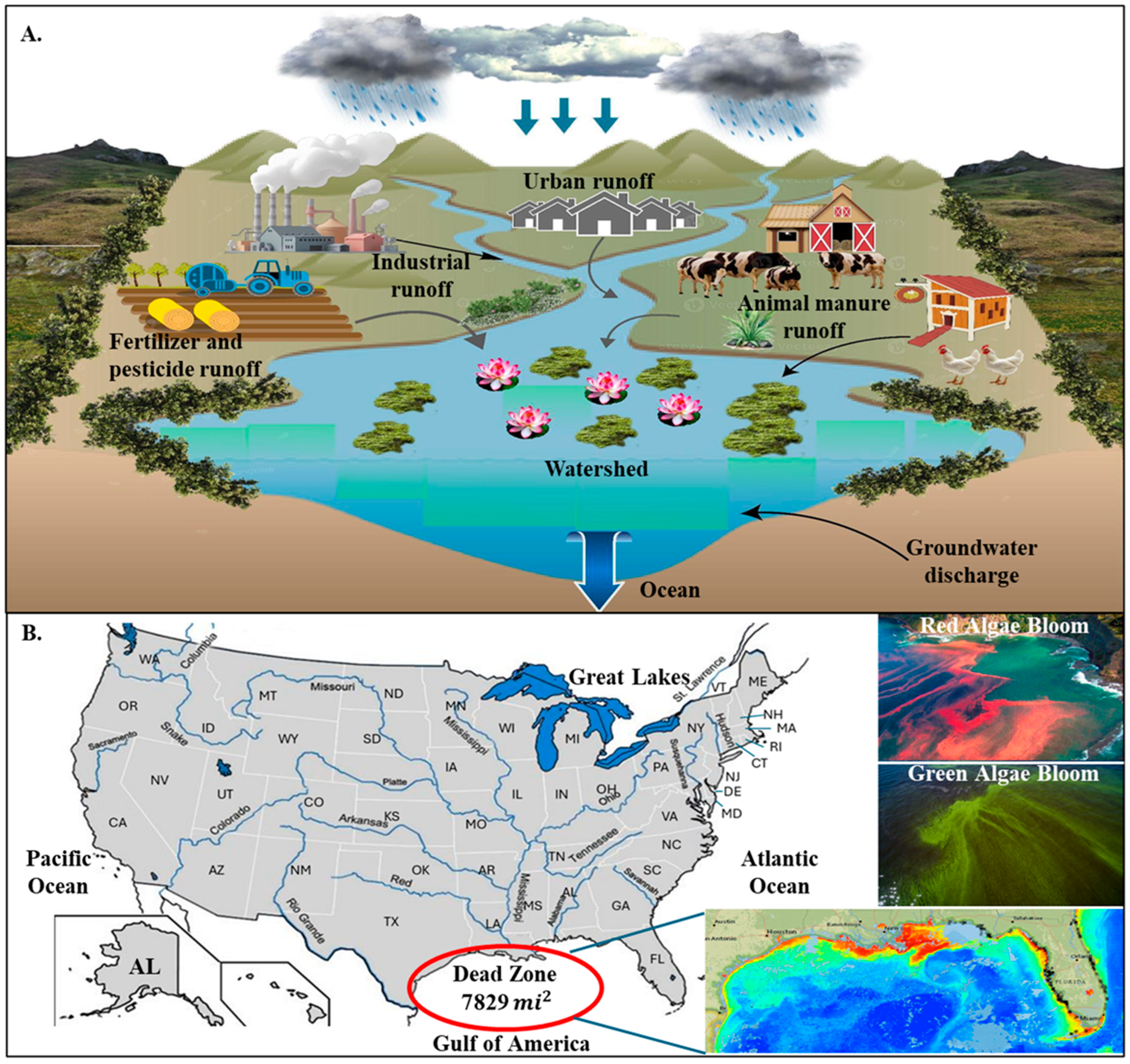
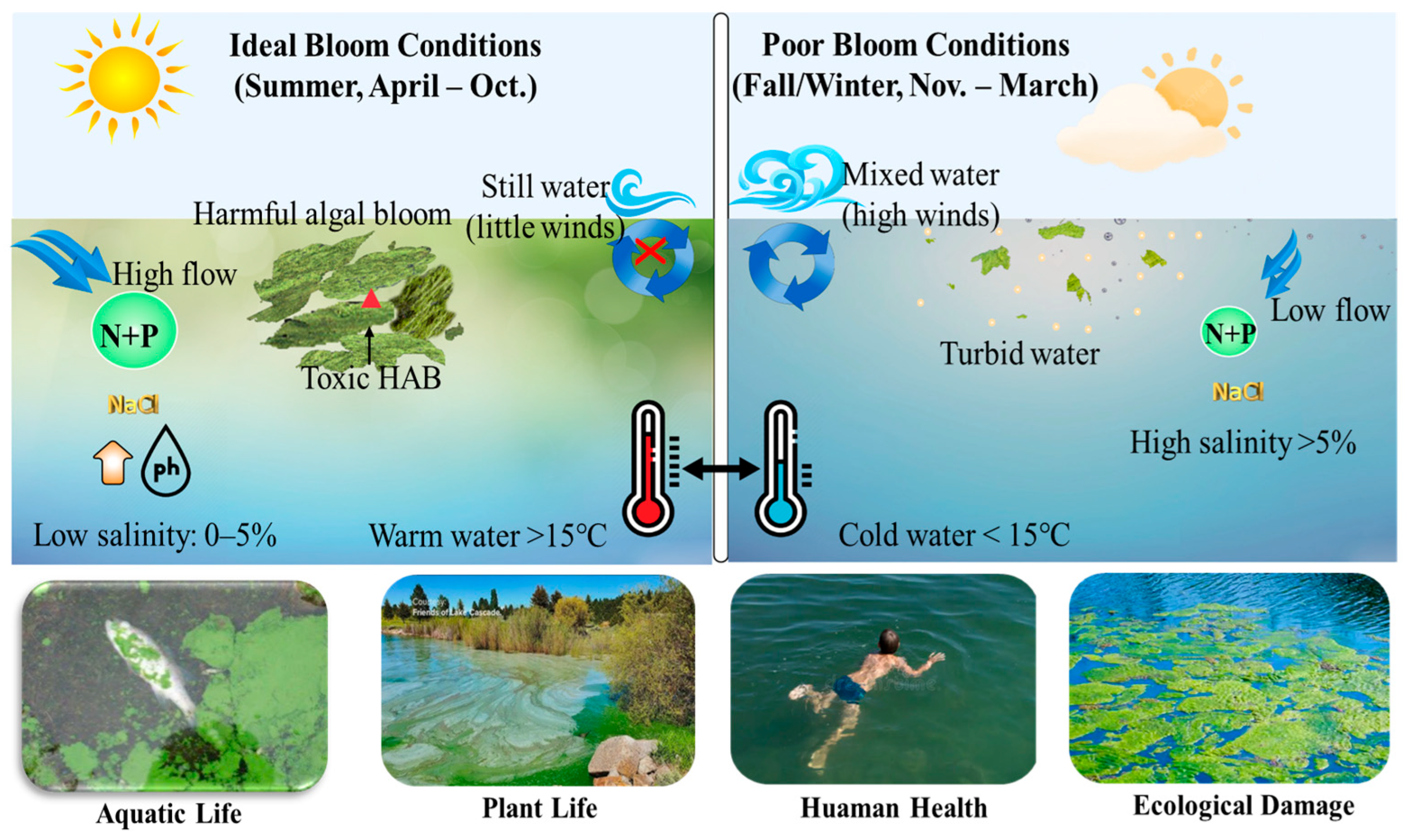
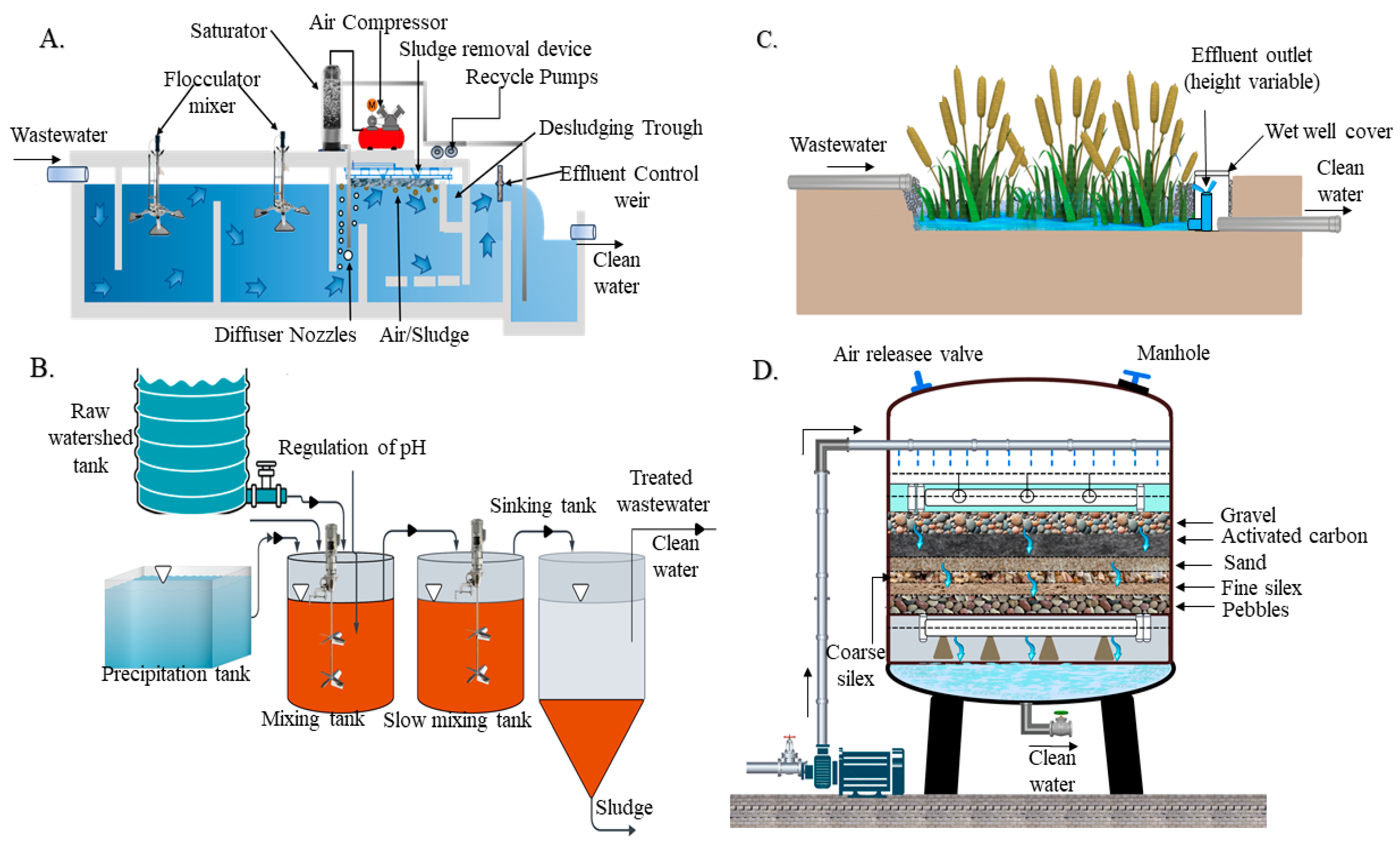

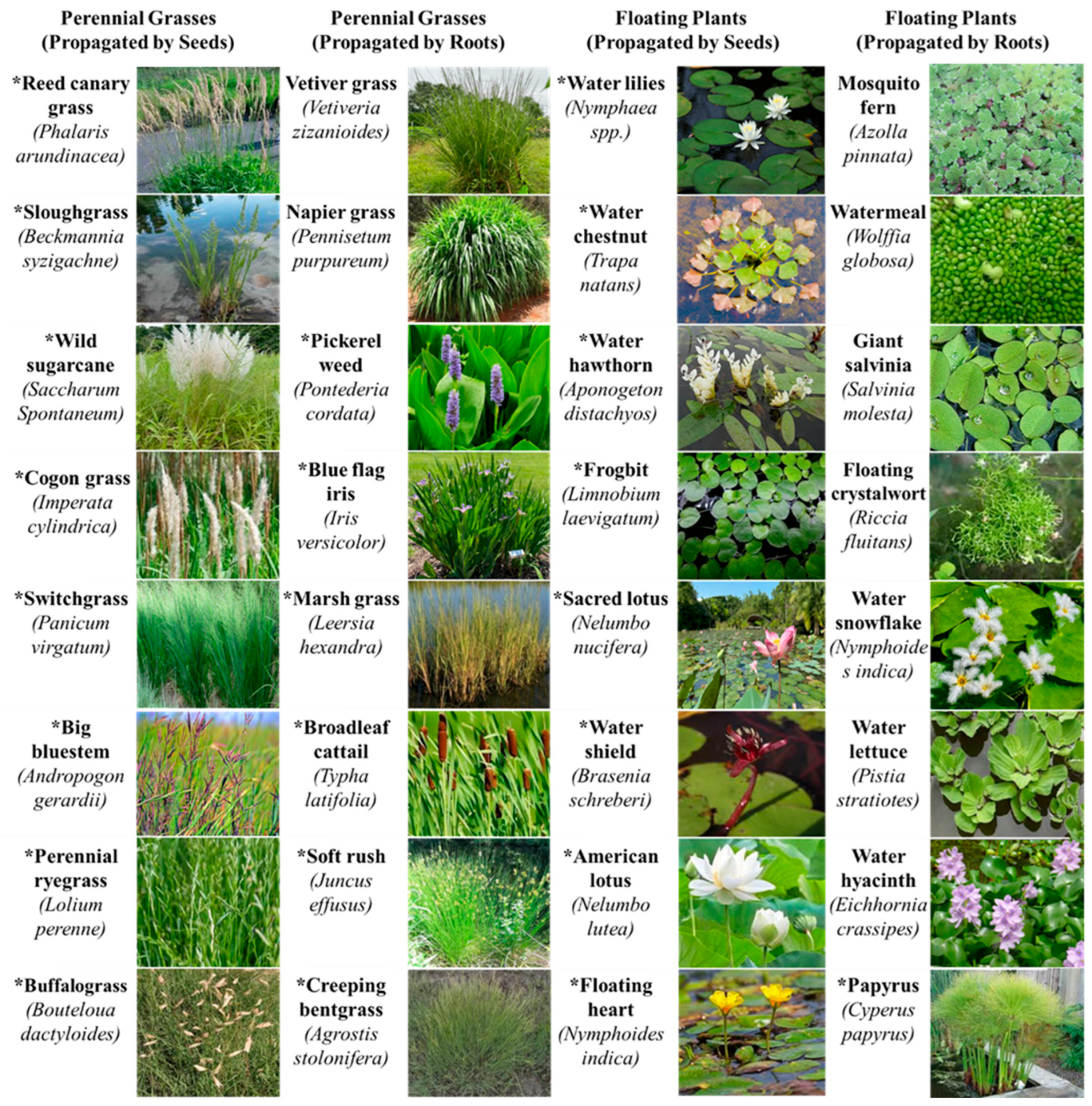
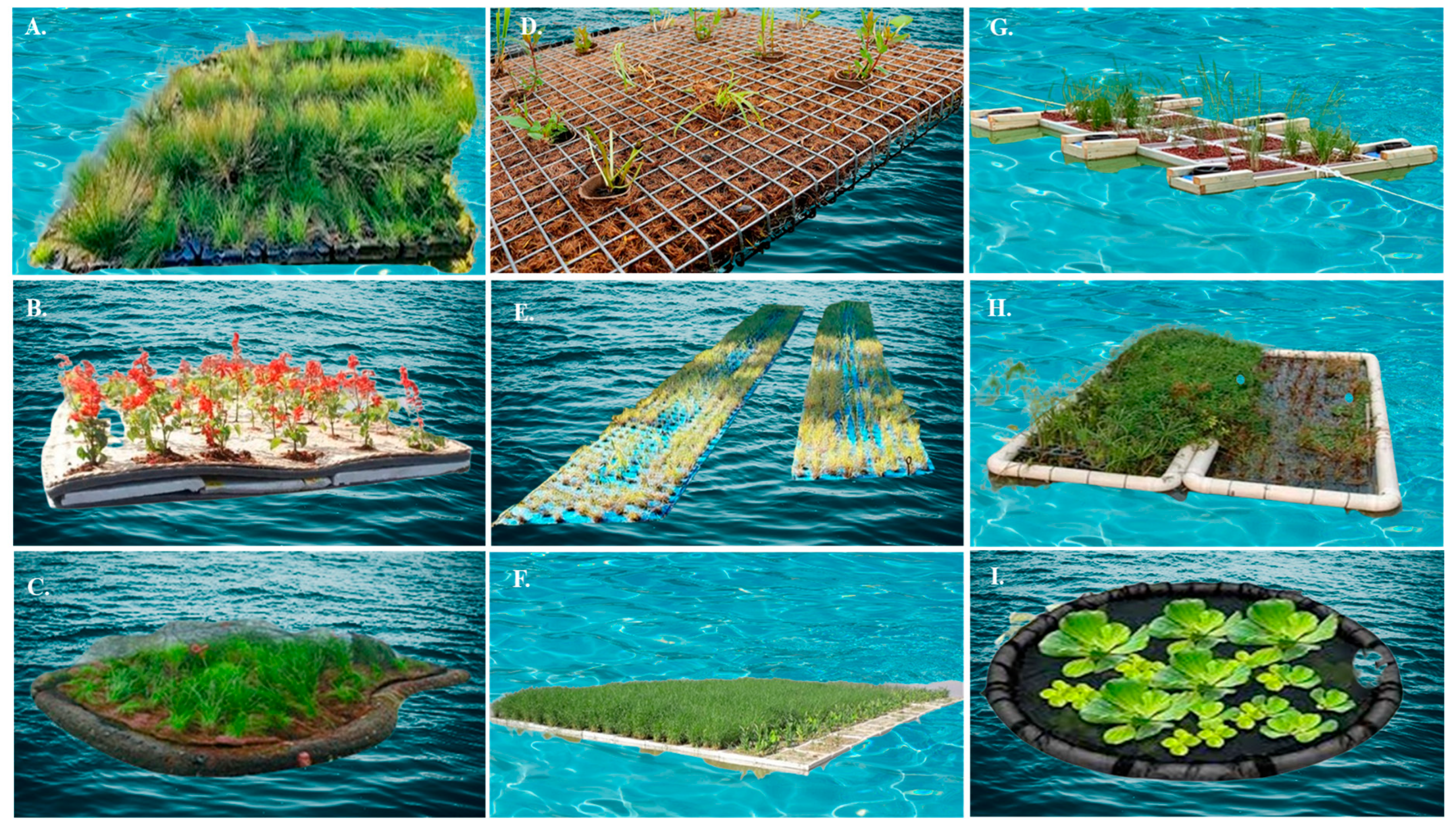
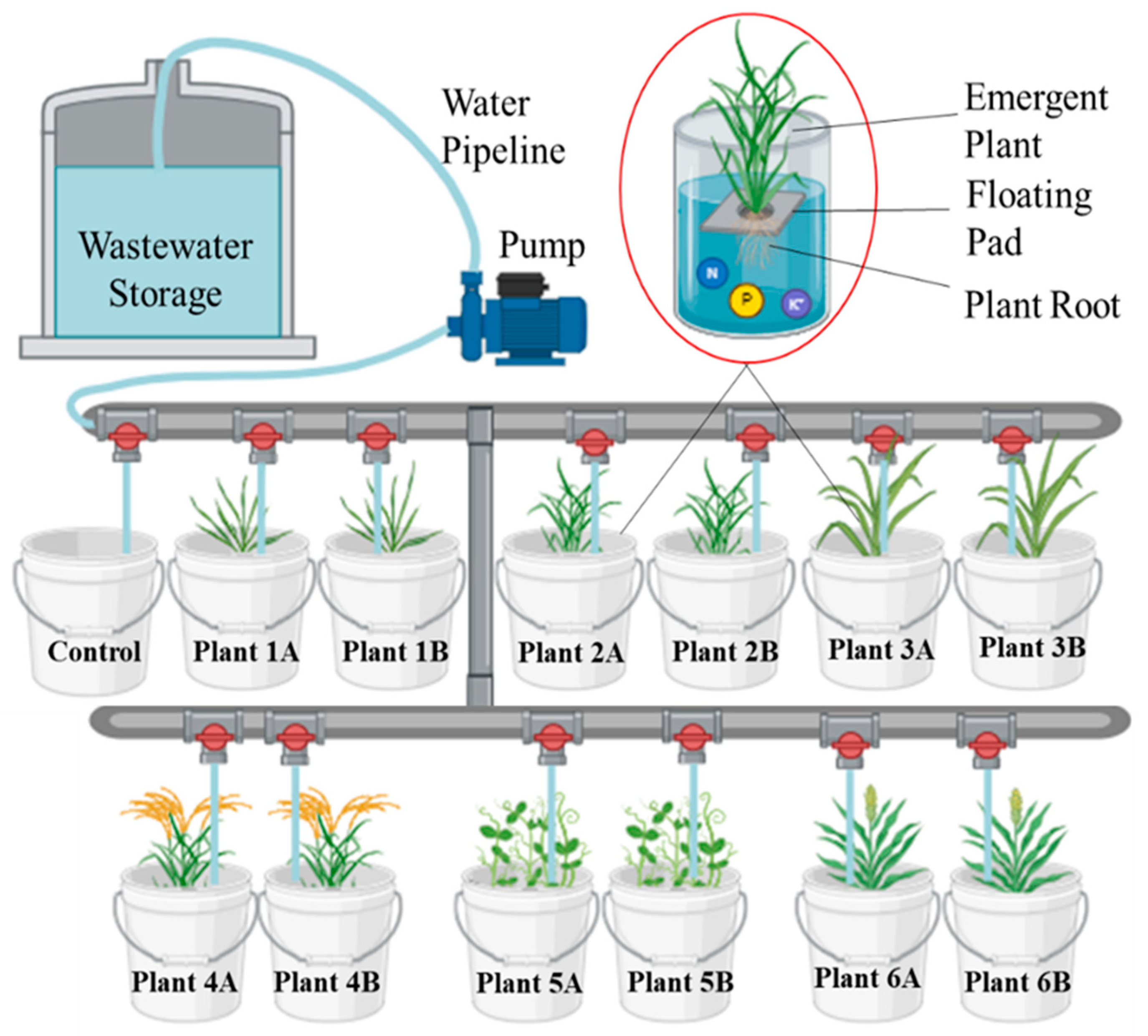
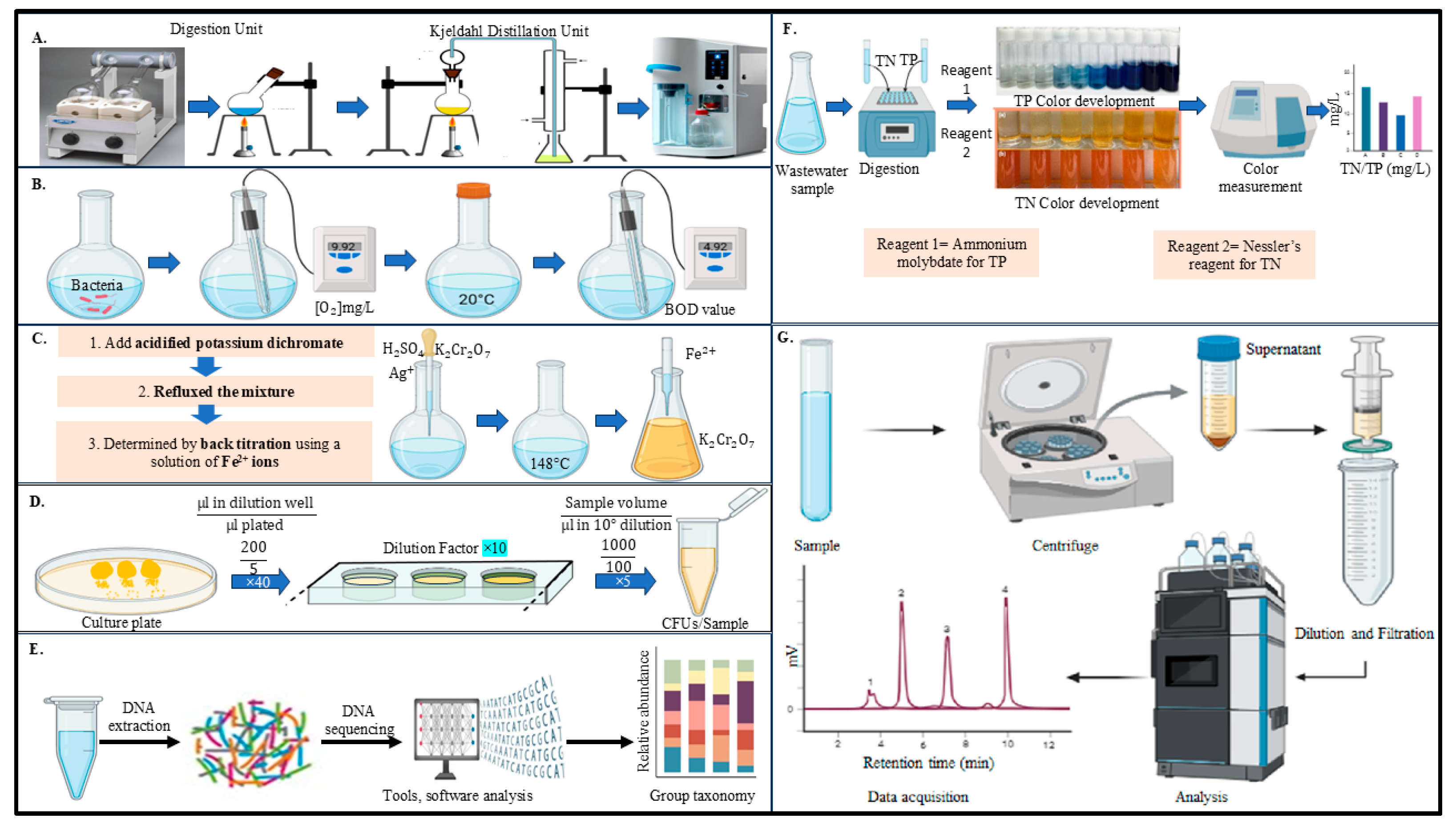
| Method | Target Pollutants | Strengths | Limitations | References |
|---|---|---|---|---|
| MAF | Suspended solids, oils, algae | High removal efficiency, compact design | Costly | [21,22] |
| ACD | Organic pollutants, pharmaceuticals | Simple, effective for trace organics | Limited for heavy metals, costly regeneration | [23,24] |
| BGCP | Nutrients, heavy metals | High efficiency, low sludge | Complex operation, chemical sludge | [25,26] |
| FTWs | Nutrients, metals, pathogens | Sustainable, habitat creation, low cost | Seasonal variability, plant maintenance | [27,28] |
| Feature | FTWs | CWs [49] | Riparian Buffers [50,51] |
|---|---|---|---|
| Installation | Modular, retrofittable on existing water bodies | Requires land excavation and grading | Requires adjacent land |
| Land Use | Minimal footprint; floats on water | High land requirement | Moderate to high |
| Pollutant Removal | Effective for nutrients, metals, and suspended solids | Broad-spectrum removal | Primarily sediment and nutrient trapping |
| Hydraulic Control | Limited; depends on water body dynamics | High; engineered flow paths | Low |
| Maintenance | Moderate (plant harvesting, mat upkeep) | Moderate to high | Low |
| Climate Adaptability | Performs well in temperate and tropical zones | Sensitive to freezing | Seasonal variability |
| Cost | Moderate initial cost; scalable | High capital cost | Low |
| Parameter | Relevance to FTWs | Typical Trend | Reference |
|---|---|---|---|
| DO | Indicates oxygenation and microbial activity | Increases post treatment | [88] |
| TN | Measures nutrient removal efficiency | Decreases significantly | [89] |
| TP | Indicates phosphorus removal and eutrophication control | Decreases significantly | [90,91] |
| CFU | Assesses microbial contamination and treatment effectiveness | Reduced in FTW outflow | [92] |
| Heavy Metals | Evaluates phytoremediation and pollutant uptake by plants | Accumulated in plant tissues | [93] |
Disclaimer/Publisher’s Note: The statements, opinions and data contained in all publications are solely those of the individual author(s) and contributor(s) and not of MDPI and/or the editor(s). MDPI and/or the editor(s) disclaim responsibility for any injury to people or property resulting from any ideas, methods, instructions or products referred to in the content. |
© 2025 by the authors. Licensee MDPI, Basel, Switzerland. This article is an open access article distributed under the terms and conditions of the Creative Commons Attribution (CC BY) license (https://creativecommons.org/licenses/by/4.0/).
Share and Cite
Kumar, N.; Singh, B.; Chen, Y.; Kafle, A.; Zhu, W.; Ray, R.L.; Kumar, S.; Shan, X.; Balan, V. The Bioremediation of Nutrients and Heavy Metals in Watersheds: The Role of Floating Treatment Wetlands. Appl. Sci. 2025, 15, 9896. https://doi.org/10.3390/app15189896
Kumar N, Singh B, Chen Y, Kafle A, Zhu W, Ray RL, Kumar S, Shan X, Balan V. The Bioremediation of Nutrients and Heavy Metals in Watersheds: The Role of Floating Treatment Wetlands. Applied Sciences. 2025; 15(18):9896. https://doi.org/10.3390/app15189896
Chicago/Turabian StyleKumar, Nirmal, Bhupinder Singh, Yuanze Chen, Abishek Kafle, Weihang Zhu, Ram L. Ray, Sandeep Kumar, Xiaonan Shan, and Venkatesh Balan. 2025. "The Bioremediation of Nutrients and Heavy Metals in Watersheds: The Role of Floating Treatment Wetlands" Applied Sciences 15, no. 18: 9896. https://doi.org/10.3390/app15189896
APA StyleKumar, N., Singh, B., Chen, Y., Kafle, A., Zhu, W., Ray, R. L., Kumar, S., Shan, X., & Balan, V. (2025). The Bioremediation of Nutrients and Heavy Metals in Watersheds: The Role of Floating Treatment Wetlands. Applied Sciences, 15(18), 9896. https://doi.org/10.3390/app15189896









